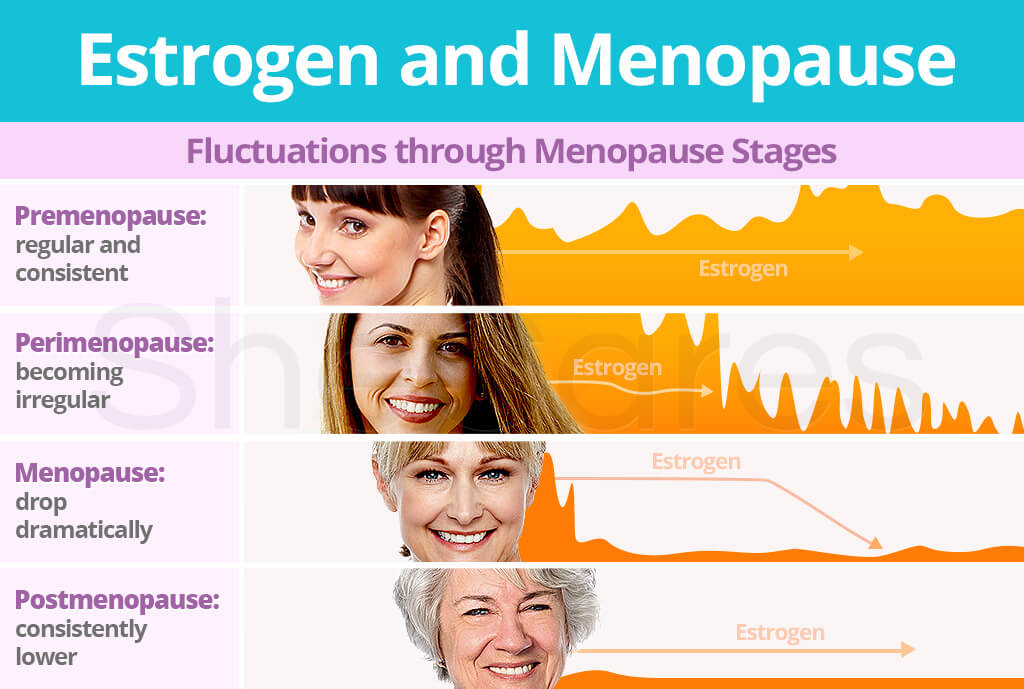Throughout life, the female body biologically progresses through various reproductive stages until it eventually transitions out of fertility. On a monthly basis, estrogen is one of the most important hormones in regulating the menstrual cycle, pregnancy, and more.
Accordingly, with the natural cessation of ovarian estrogen production comes the menopausal transition as hormone levels fall.
Continue reading to learn more about the fluctuations of estrogen across the menopausal stages and the myriad of symptoms hence provoked, from hot flashes and mood swings to hair loss and incontinence.
Fluctuations of Estrogen during Menopausal Stages
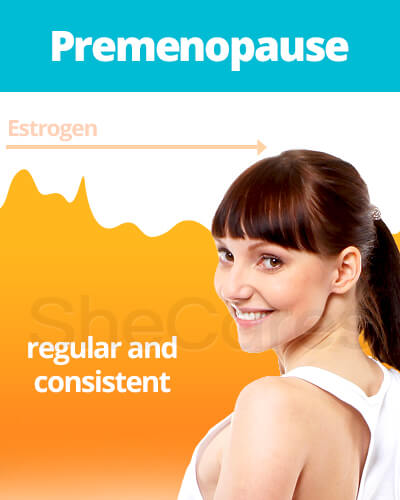
Premenopause
Although premenopause and perimenopause are used interchangeably, premenopause can be considered the first stage that begins with menarche and ends with the initiation of perimenopause.
It is during this time that a woman is in prime reproductive years as natural fluctuations of estrogen guide each menstrual cycle. Certain diseases and lifestyle factors may throw off hormonal balance and cause irregularities.
Perimenopause
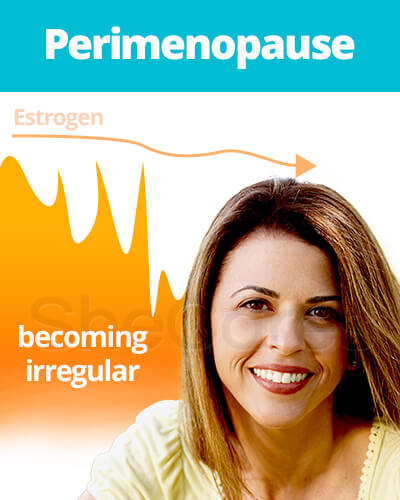
Perimenopause usually occurs two to eight years before the onset of menopause. It begins with irregular menstrual cycles and ends a year after the last menstrual cycle. Nevertheless, it is possible for women to experience symptoms as early as their mid-30s.
Although there is a continuous, natural decline in ovarian estrogen production, high levels of estrogen can evolve as the body compensates for the drop in progesterone production as well.
Menopause
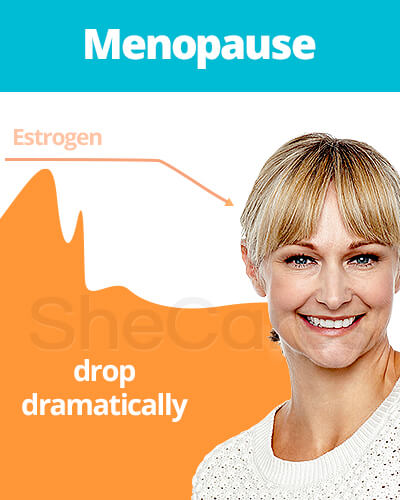
On average, the North American woman will reach natural menopause around age 51. However, as aforementioned, the beginning of the menopausal transition can occur earlier, causing a woman to reach menopause at a younger age.
Menopause is defined as a point in time when a woman has gone 12 consecutive months without a menstrual period. At this time, estrogen levels have been decreasing and fluctuating until menstruation stops.
Postmenopause
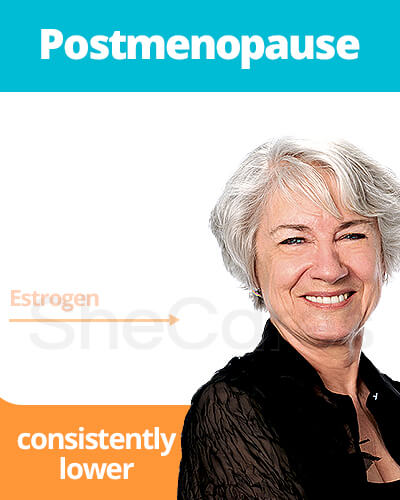
After menopause, a woman is considered postmenopausal. For decades prior, the ovaries have produced the majority of the body's estradiol. During postmenopause, blood estrogen levels drop dramatically, and much of women's estrogen is derived from converting androgens to estrogen in body fat.
This lack of circulating estrogen triggers a new range of health risks aside from already burdening symptoms. These health risks from postmenopausal estrogen levels include osteoporosis and cardiovascular disease.
Estrogen and Menopause Symptoms
Estrogen levels can become extremely unbalanced throughout the various stages of menopause. These hormonal fluctuations can cause numerous signs and symptoms, which can mistakenly resemble other conditions.
Premenopause
During monthly menstruation, women may exhibit a range of symptoms from premenstrual syndrome (PMS). These symptoms typically appear after ovulation when estrogen levels are lowest. Keep in mind that some symptoms of PMS can be similar to those of early pregnancy. They include:
- Acne
- Mood swings
- Irritability
- Fatigue
- Swollen or tender breasts
- Difficulty concentrating
- Trouble sleeping
- Constipation or diarrhea
- Anxiety
- Food cravings
- Headaches
- Bloating
- Aching joints
- Muscle pain or tension
Perimenopause and Menopause
During perimenopause, women may show a range of PMS symptoms as well as those commonly known as menopause symptoms. Symptoms of low estrogen in menopause include, but are not limited to:
- Hot flashes
- Mood swings
- Vaginal dryness and itching
- Disturbed sleep
- Irritability
- Fatigue
- Memory lapses
- Difficulty concentrating
- Anxiety
- Headaches
- Depression
- Hair loss or thinning
- Sleep disorders
- Loss of libido
- Dizziness
- Weight gain
- Incontinence
- Bloating
- Changes in body odor
- Rapid heart rate
- Aching joints
- Increased muscle tension
- Itchy or crawly skin
- Tingling extremities
Postmenopause
For postmenopausal women, there are additional concerns due to continued low levels of estrogen and other hormones. Health risks during this time are more serious and can be long-term. Some of these health conditions include:
- Allergies
- Osteoporosis
- Arthritis
- Thyroid dysfunction
- Dyspareunia
- Vaginal atrophy
- Urinary incontinence
- Urinary tract infections
- Breast or uterine cancer
- Cardiovascular disease
- Heart disease
- Strokes (less common)
- Lupus (less common)
- Gallbladder disease (less common)
Understanding the importance of estrogen during and after reproductive years is a crucial step toward helping women go through the transition more consciously.
Nevertheless, having low estrogen levels or high estrogen levels brings about its own list of distinct signs and symptoms that can throw a woman's body into calamity. To discover more about healthy estrogen levels, click on the preceding link.
Sources
- Harvard Health Publications. (2017). Perimenopause: Rocky road to menopause. Retrieved July 10, 2017, from http://www.health.harvard.edu/womens-health/perimenopause-rocky-road-to-menopause
- Luthje, P et al. (2013). Estrogen Supports Urothelial Defense Mechanisms. Science Translational Medicine, 5(190), 190ra80. doi: 10.1126/scitranslmed.3005574
- The North American Menopause Society. (2010). Changes in Hormone Levels. Retrieved July 10, 2017, from https://www.menopause.org/for-women/sexual-health-menopause-online/changes-at-midlife/changes-in-hormone-levels
- National Women's Health Network. (2011). Menopause, Hormone Therapy, & Aging Skin - Is There a Connection? Retrieved August 1, 2017, from https://www.nwhn.org/menopause-hormone-therapy-aging-skin-is-there-a-connection/
- National Women's Health Resource Center, Inc. (2017). Estrogen. Retrieved August 1, 2017, from http://www.healthywomen.org/condition/estrogen
- NHS. (2015). Symptoms of the menopause. Retrieved August 1, 2017, from http://www.nhs.uk/Conditions/Menopause/Pages/Symptoms.aspx
- Northwestern University: Women's Health Research Institute. (2013). How Hormone Depletion Affects You. Retrieved July 10, 2017, from http://menopause.northwestern.edu/content/how-hormone-depletion-affects-you
- The Physicians Committee. (n.d.). A Natural Approach to Menopause. Retrieved August 1, 2017, from http://www.pcrm.org/health/health-topics/a-natural-approach-to-menopause
- Suzuki, N. et al. (1995). A possible role of estrone produced in adipose tissues in modulating postmenopausal bone density. Maturitas, 22(1), 9-12. Retrieved August 1, 2017, from https://www.ncbi.nlm.nih.gov/pubmed/7666818
- University of Maryland Medical Center. (2012). Menopause. Retrieved August 1, 2017, from http://www.umm.edu/health/medical/reports/articles/menopause
- U.S. Food & Drug Administration. (2017). Menopause and Hormones: Common Questions. Retrieved July 10, 2017, from https://www.fda.gov/forconsumers/byaudience/forwomen/ucm118624.htm
